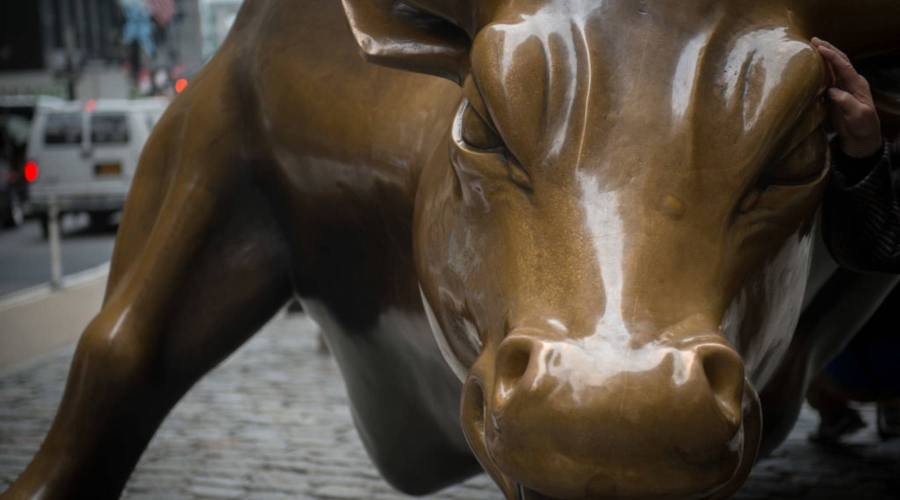Where do the terms “bear” and “bull” markets come from?

A major stock index entered “bear” market territory recently. One of our listeners is wondering why we call it a “bear” or “bull” market and where those terms come from. We have some answers. Plus, more of your questions about gun manufacturing, the Federal Reserve and why the heck Mariah Carey is getting sued over her holiday hit “All I Want For Christmas Is You” almost 30 years after it was released?
Here’s everything we talked about today:
- “Why we use animals to describe what’s going on with the stock market or economy” from Marketplace
- The Gun Industry in America from The Center for American Progress
- “President Biden calls for assault weapons ban and other measures to curb gun violence” from NPR
- “Colt Says Its Decision to Stop Making AR-15 Rifles for Civilians Is Driven by Customers. Experts Aren’t So Sure” from TIME Magazine
- “How Mariah Carey’s Christmas Hit Can Still Face a Copyright Lawsuit 30 Years Later” from Billboard
If you have a question you’d like us to find the answer to, send it our way. We’re at makemesmart@marketplace.org and (508) 827-6278 or (508) U-B-SMART.
Make Me Smart June 8, 2022 transcript
Note: Marketplace podcasts are meant to be heard, with emphasis, tone and audio elements a transcript can’t capture. Transcripts are generated using a combination of automated software and human transcribers, and may contain errors. Please check the corresponding audio before quoting it.
Kai Ryssdal: It’s a long ten seconds. There we go, it’s a long ten seconds, everybody. Well, so what happens is Charlton says, Okay, ten. He’s the only guy does it by the way. It just felt longer. Yeah.
Kimberly Adams: Yeah, it makes me anxious.
Kai Ryssdal: A little bit, a little bit, right? I’m Kai Ryssdal. Welcome back to Make Me Smart where we make today make sense with 10-second warnings. That’s what we do.
Kimberly Adams: Yes. I’m Kimberly Adams. Thank you for joining us for Whaddya Wanna Know Wednesday. And you know, if you want to know why Charlton is the only one who does that, maybe you should ask him.
Kai Ryssdal: We should definitely do that! Next Wednesday, we’re gonna answer that question: why is Charlton the guy? Right now I can promise you, he’s sitting in the control room in downtown Los Angeles, going “What even is happening right now? Leave me out of this.” Anyway.
Kimberly Adams: But this is actually the show where we’re going to answer your questions, our lovely audience’s questions. Because thank you for sending them! And we all want to get smarter.
Kai Ryssdal: Yes, we do. You know the drill, right? Email us at makemesmart@marketplace.org or leaves us a voicemail. Our phone number is 508-U-B-SMART.
Kimberly Adams: All right, let’s get to the first question of the day. It comes from Tamra, and forgive me if it’s Tuh-my-ra. But you know, all kinds of ways. She writes, “I’m tremendously curious if you know where the term bear and bull market come from, and how you keep those terms straight? Looking for some help.” This sounds all about you, Kai.
Kai Ryssdal: All right. So let’s define some terms first, right? So a bear market is one where stocks have declined 20% from their most recent high, right? And you might have heard me say this on the air a couple of weeks ago. At least one of the major indices was in bear market territory, right? Happens with some degree of regularity, right? It’s a normal function of markets, they go up and they go down too. And a bear market is when something has gone down 20% or more from its most recent high. A correction by the way – just for your own edification and dinner party use, Tamra – is 10% or more from the most recent high. So that’s the downside of it. A bull market has no numerical indicator to it. It’s just a feeling and a trendline of stocks going up, right? So bears down bull is up. Now. Why? I don’t know. Our friend, our colleague at the BBC, Victoria Craig, did an interview with a person named Dhruti Shah, who wrote a book called Bear Markets And Beyond, who talks about why we use animals and how we use animals to explain what’s happening in the financial markets. People believe the whole bear bull thing goes back at least as far as the 18th century, I’ve seen suggestions that Shakespeare is at some point, the cause of talking about bears and bulls with what were then probably, you know, trading posts under trees out in Avon. In… who knows?
Kimberly Adams: Strapford-upon-avon.
Kai Ryssdal: Right sorry, Stratford upon it. I apologize. That’s right. So here’s a little tidbit from Victoria’s book, which is totally interesting, actually. 130 animals are listed in that book. Again, it’s Bear Markets And Beyond. Dhruti Shah wrote it. Everything from swans – we’ve also got black swans, right? We had that during the financial crisis. Unicorns and decacorns. Unicorns are startup companies worth a billion dollars, decacorns are startup companies worth 10 billion dollars, right? And here’s actually the functional reason behind this. It makes financial literacy easier. Because once you figure out bear is down and bull is up, you don’t have to know what the numbers are. You just know, okay, that’s generally speaking the trend is down; generally speaking the trend is up. And that helps you understand what’s going on and makes it less opaque. And look, when I first got into doing business in the economy, I had no clue which way was up. And this just really helps. That’s it. It’s also shorter to write when you’re tight on time. Bull market as opposed to “down 20% from its recent high”. Yeah, it is totally quicker. That’s totally for sure. All right. Another question. This one comes from Emily in California. She wants to know this. Is there some way to force manufacturers to stop or slow down production of new guns, Miss Adams?
Kimberly Adams: Let’s see. Yes, but it’s hard. For some background here. US gun manufacturing has actually grown in recent years. We are making as a country more guns than ever. The Center for American Progress crunched some numbers using ATF data – that’s the Bureau of Alcohol, Tobacco and Firearms – and from 1986 to 2008, an annual average of 3.8 million firearms were manufactured in the US. But then that average doubled and doubled to 8.4 million firearms per year from 2009 to 2018. Now a lot of that is rifle and pistol production is where a lot of that growth is, and also an increase in the number of licensed gun manufacturers. So more companies making guns. It grew 255% from 2009 to 2018. Not a lot of barriers to entry in the gun manufacturing sector, it seems, but three manufacturers are responsible for producing more than 58% of at least pistols from 2008 to 2018. Smith and Wesson, Sturm Ruger & Co., and Sig Sauer, is that how you say it, Kai?
Kai Ryssdal: Yep, yep.
Kimberly Adams: Forgive my lack of familiarity with gun companies. Now, is there a way to force them to stop production of firearms? Technically, yes. You could pass a law that make guns illegal in the United States and illegal to manufacture guns in the United States. That is something Congress could do and the White House could sign. Now that’s not realistic in any way, shape, or form, and would be a violation of the Second Amendment pretty clearly and all other things. However, the federal government could restore the assault weapons ban, which President Biden has called for. And that would prohibit the manufacture and sale of certain semi-automatic weapons. These are the guns that are often used in these mass shootings that kill a lot of people and injure a lot of people in a very short amount of time. However, an assault weapons ban doesn’t look like it’s really going anywhere. Senator Chris Murphy, who’s leading these bipartisan talks on gun legislation here in Washington, says that of the things they’re considering, an assault weapons ban is not one of them. On the other hand, gun manufacturers could do something on their own. For example, a few years ago, Colt decided to stop making AR-15 rifles. Now they said at the time, that it was a market decision. But a lot of people watching this space, and experts in the field, think that they just got tired of their company name being associated with mass shootings. So it’s doable. Obviously states can take action where the federal government doesn’t. I think there’s some stuff in California where you are, Kai.
Kai Ryssdal: Yeah, there is. Sorry, what you just said. The whole Chris Murphy thing and the John Cornyn negotiations obviously have been top of mind for me, and I hate to be the the naysayer on this one. I just. I don’t know how to get ten Republicans to sign on to any kind of gun control or gun safety legislation. I don’t know.
Kimberly Adams: It’s gonna be hard. But both of these guys have political ambitions. And I think that one part of this is demonstrating what can be done. Like, can you corral your colleagues on the GOP side, because if say, the GOP does take over the House or the Senate in the future, there’s gonna be people, you know, clamoring for leadership positions. And if you can tout that you push this over the finish line and had bipartisan support, that’s a good talking point for somebody. And I hate to break it down to that kind of narrative. But you know, it’s
Kai Ryssdal: But that’s how it gets done, right?
Kimberly Adams: And, you know, favors may be exchanged. If you can say, do this for me, and I’ll help you with this other legislation down the road. That’s how politicking gets done. So I’m going to remain optimistic. We’ll do a version of half full, half empty here.
Kai Ryssdal: Yeah, that’s fair. That’s fair.
Kimberly Adams: All right. Next question. Yes.
Kai Ryssdal: Yes. Let’s do that. Here we go.
Vinay Kumar: Hi. My name is Vinay Kumar. I’m calling from Chandler, Arizona. I was wondering why the Federal Reserve doesn’t get more involved in retail banking. It seems like their dual mandate can be better achieved if they were to directly distribute funds or have more to do with retail banking, since that is who they target anyway. Make me smart. Love the show. Thank you.
Kai Ryssdal: A great and entirely reasonable question. Yes. And thank you for the compliment. So look, let’s do it super quick. Dual mandate, right? The Congress has given the Fed instructions that it is supposed to do two things, maximum employment and stable prices. Maximum employment of course is the unemployment rate, and stable prices is of course, inflation. And one of those is out of whack right now. But let’s think about the other thing that the Federal Reserve is required by law to do and that is to be, in essence, the banker to the really, really big systemically important banks. Right. I could say Wall Street banks, but they are systemically important in this and the global economy.
Kimberly Adams: Can you give a couple of examples?
Kai Ryssdal: Oh, sure. JP Morgan, Goldman Sachs, Morgan Stanley. You know the names. You hear them on marketplace all the time. Those are the ones who established markets. They are, some of them, what are called primary dealers for the New York Federal Reserve, when the New York Federal Reserve takes the action that the Federal Reserve Board of Governors requires it to do to manipulate and change interest rates. I don’t want to get too deep into the plumbing. But that’s what the Fed is for. Yes, I hear the intake of breath.
Kimberly Adams: Well, it’s just I was asking, because sometimes when we say retail banking, you know, I’m thinking about the banks you and I go to, which is different than the JP Morgans and the Goldman Sachs.
Kai Ryssdal: Right. So let’s get there, right, because I actually am a client of JP Morgan Chase, right, I have my savings account and or my wife does, because she is in charge of all our money, and I basically get an allowance. That’s not true. But you know what I mean, she’s in charge of all money. But there are high level interactions with the Federal Reserve, is what the Federal Reserve is required to do by law. The Fed is not allowed to get into the checking account business, right? I mean, it does have check clearing houses, and it does a bunch of banking operations. But it doesn’t actually do direct to consumer retail banking. The Federal Reserve is actually not allowed to do that. And that’s why the Fed doesn’t. Do they want to help the person on main Street? Yes, of course they do. Do they do that via the tools they have, which are, as Jay Powell has said repeatedly, very blunt instruments? Yes. But they are actually not allowed to be in the retail banking services business. So there you go.
Kimberly Adams: That made me smarter. Thanks. It’s a really good question.
Kai Ryssdal: Yeah it totally was, actually. A really, really good question. Last question today comes from Christine. She’s on Twitter. Here’s what she says. Mariah Carey got hit with a copyright lawsuit over her holiday hit. All I Want For Christmas Is You. And Christine is wondering, just now? After all these years? Make me smart. She says.
Kimberly Adams: So this is interesting. I saw this on Twitter as well. And Billboard has a really good explainer on this. But before I get to that explanation, let’s just lay out what we’re talking about here. So we got some tape. First of all, here’s Mariah Carey’s version of All I Want For Christmas Is You. Okay, and now here’s the other version of this song, All I Want For Christmas Is You, that’s the subject of this lawsuit. Okay, very, very different songs.
Kai Ryssdal: I had not heard those two back-to-back. That’s great. Thank you, by the way for the ear worm, Kimberly Adams.
Kimberly Adams: You’re welcome. You’re welcome. You know, Christmas in June. This lawsuit is happening because the Supreme Court says it can happen. Mariah Carey was hit with this infringement lawsuit last Friday by an artist who says that she stole his song. That’s the second song. And even though this song, Mariah Carey’s version of the song is over 30 years old. In 2014, the Supreme Court overturned long standing rules on how long a copyright owner can wait before taking action in court. So here’s what Billboard has to say about this. Up until the 2014 decision, there was a time window that said if you aren’t sued for many years, the court system says it’s fair to assume that you’re in the clear. But now the court says that doesn’t apply to copyright cases, as long as someone is sued within the Copyright Act’s three-year window. So what this basically means is every single time somebody streams or plays All I Want For Christmas Is You, that three-year clock starts over again. And so someone can sue for copyright infringement. Yes. Now, just because this is possible, does not mean that this person is going to win. But you know, might lose their streams for their own songs.
Kai Ryssdal: Sure, totally. Totally. That’s so fascinating. I had no idea about any of that stuff. That’s great.
Kimberly Adams: Yeah. All right. That is it for us for today. Thank you for listening to us and for, you know, just generally being awesome. We’re gonna be back tomorrow with news and some smiles.
Kai Ryssdal: In the meanwhile, don’t forget to send us your questions for Whaddya Wanna Know Wednesday, email us and makemesmart@marketplace.org. Leave us a voice memo. 508-U-B-SMART and we’ll get you on the pod.
Kimberly Adams: Make Me Smart is produced by Marissa Cabrera. Olivia Zhao is our new intern. Ellen Rolfes writes our newsletter.
Kai Ryssdal: Today’s show was engineered by Charlton Thorp. Ben Tolliday and Daniel Ramirez composed our theme music. Our senior producer is Bridget Bodnar.
None of us is as smart as all of us.
No matter how bananapants your day is, “Make Me Smart” is here to help you through it all— 5 days a week.
It’s never just a one-way conversation. Your questions, reactions, and donations are a vital part of the show. And we’re grateful for every single one.


















